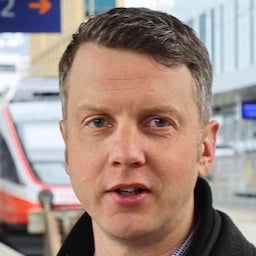ÖBB explains the principle
Smart technology: brakes supply new energy
ÖBB shows what efficiency looks like. Three trains from the Brenner Pass to Innsbruck "transport" one back again. A clever technology with the brakes makes this possible. A company spokesperson explains how it works. And he provides some exciting figures.
At the latest since the war of aggression in Ukraine and the subsequent sharp rise in prices, it should be clear to everyone that energy is a precious and expensive commodity. ÖBB not only relies on green electricity - generated from photovoltaic systems, for example - but also on other methods of generating energy.
One of these, which may sound strange to the uninitiated, is so-called braking energy.
With e-braking, the train's electric motor is operated in reverse. Instead of consuming energy, the motor acts as a generator.

Christoph Gasser-Mair
Bild: Christof Birbaumer
Kinetic energy is converted into energy
Christoph Gasser-Mair, ÖBB press spokesman for Tyrol and Vorarlberg, explains to the "Krone" how it works. He says that "when a train brakes, the kinetic energy is normally converted into heat. This energy is then lost". Since the delivery of the "Taurus" fleet in 2000, however, the company has relied on e-brakes.
"With the e-brake, the train's electric motor is operated in reverse. Instead of consuming energy, the motor acts as a generator. When the train brakes, the kinetic energy of the train is converted into electrical energy," explains the press spokesman in plain language.
Total energy consumption is reduced
The energy generated in this way is then fed back into the power grid. "The energy generated during braking is then either available to other trains or other electrical systems," explains Gasser-Mair. Feeding energy back into the grid also reduces the train's overall energy consumption. "Trains with e-brakes can be operated more efficiently as they require less energy from external sources."
This could supply 75,000 households for a year.

Christoph Gasser-Mair
Bild: Christof Birbaumer
300 million kilowatt hours less consumed per year
The press spokesman also provides some impressive figures. Under optimal conditions, the braking energy can reduce energy consumption by up to a maximum of 25 percent. "In total, around 300 million kilowatt hours less energy is consumed per year. This could supply 75,000 households for a year," calculates Gasser-Mair.
Three trains from the Brenner "transport" one back
Finally, he has another exciting comparison: "When three trains with a 'Talent' railcar travel from the Brenner to Innsbruck, as much electrical energy is generated during braking as one railcar needs for the journey from Innsbruck up to the Brenner."
The same comparison also works for freight trains with 1500 tons.
This article has been automatically translated,
read the original article here.












Liebe Leserin, lieber Leser,
die Kommentarfunktion steht Ihnen ab 6 Uhr wieder wie gewohnt zur Verfügung.
Mit freundlichen Grüßen
das krone.at-Team
User-Beiträge geben nicht notwendigerweise die Meinung des Betreibers/der Redaktion bzw. von Krone Multimedia (KMM) wieder. In diesem Sinne distanziert sich die Redaktion/der Betreiber von den Inhalten in diesem Diskussionsforum. KMM behält sich insbesondere vor, gegen geltendes Recht verstoßende, den guten Sitten oder der Netiquette widersprechende bzw. dem Ansehen von KMM zuwiderlaufende Beiträge zu löschen, diesbezüglichen Schadenersatz gegenüber dem betreffenden User geltend zu machen, die Nutzer-Daten zu Zwecken der Rechtsverfolgung zu verwenden und strafrechtlich relevante Beiträge zur Anzeige zu bringen (siehe auch AGB). Hier können Sie das Community-Team via unserer Melde- und Abhilfestelle kontaktieren.